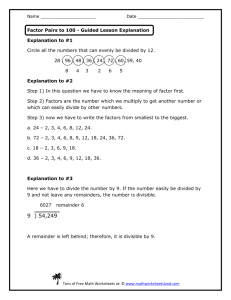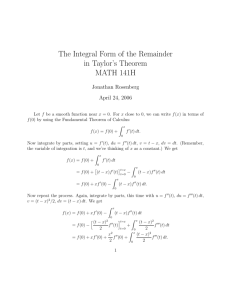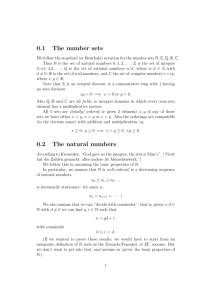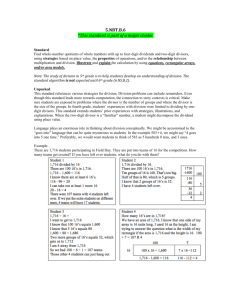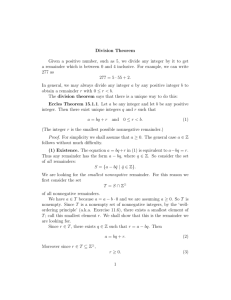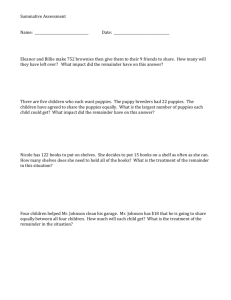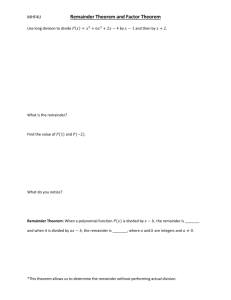E036 - The Euler Archive
advertisement
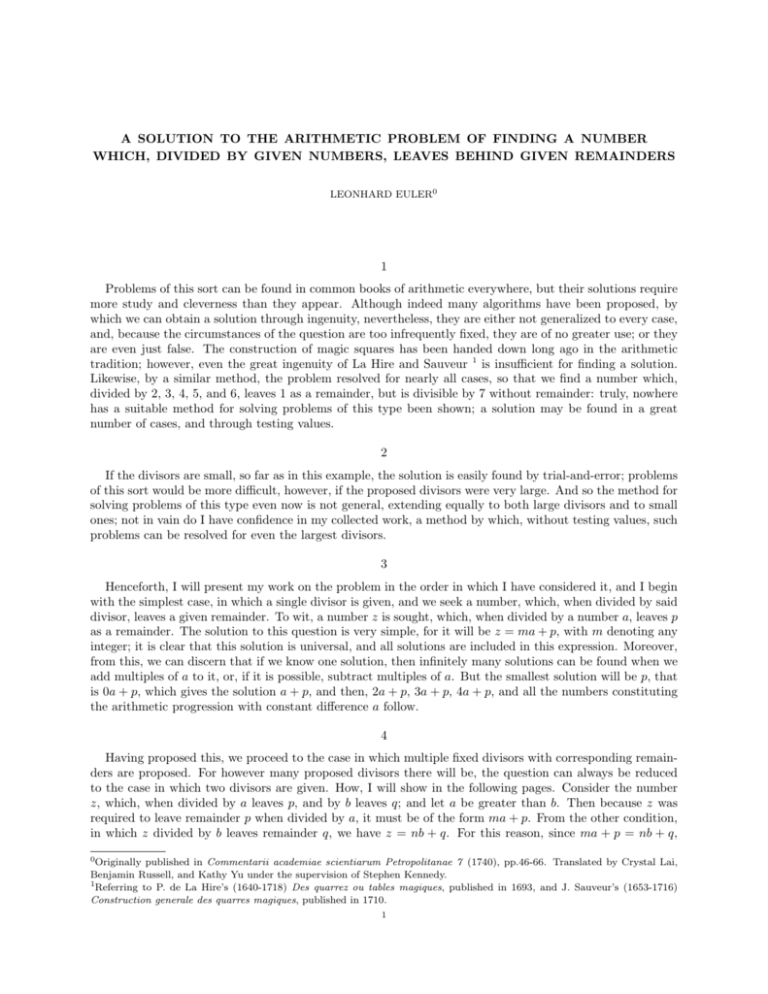
A SOLUTION TO THE ARITHMETIC PROBLEM OF FINDING A NUMBER WHICH, DIVIDED BY GIVEN NUMBERS, LEAVES BEHIND GIVEN REMAINDERS LEONHARD EULER0 1 Problems of this sort can be found in common books of arithmetic everywhere, but their solutions require more study and cleverness than they appear. Although indeed many algorithms have been proposed, by which we can obtain a solution through ingenuity, nevertheless, they are either not generalized to every case, and, because the circumstances of the question are too infrequently fixed, they are of no greater use; or they are even just false. The construction of magic squares has been handed down long ago in the arithmetic tradition; however, even the great ingenuity of La Hire and Sauveur 1 is insufficient for finding a solution. Likewise, by a similar method, the problem resolved for nearly all cases, so that we find a number which, divided by 2, 3, 4, 5, and 6, leaves 1 as a remainder, but is divisible by 7 without remainder: truly, nowhere has a suitable method for solving problems of this type been shown; a solution may be found in a great number of cases, and through testing values. 2 If the divisors are small, so far as in this example, the solution is easily found by trial-and-error; problems of this sort would be more difficult, however, if the proposed divisors were very large. And so the method for solving problems of this type even now is not general, extending equally to both large divisors and to small ones; not in vain do I have confidence in my collected work, a method by which, without testing values, such problems can be resolved for even the largest divisors. 3 Henceforth, I will present my work on the problem in the order in which I have considered it, and I begin with the simplest case, in which a single divisor is given, and we seek a number, which, when divided by said divisor, leaves a given remainder. To wit, a number z is sought, which, when divided by a number a, leaves p as a remainder. The solution to this question is very simple, for it will be z = ma + p, with m denoting any integer; it is clear that this solution is universal, and all solutions are included in this expression. Moreover, from this, we can discern that if we know one solution, then infinitely many solutions can be found when we add multiples of a to it, or, if it is possible, subtract multiples of a. But the smallest solution will be p, that is 0a + p, which gives the solution a + p, and then, 2a + p, 3a + p, 4a + p, and all the numbers constituting the arithmetic progression with constant difference a follow. 4 Having proposed this, we proceed to the case in which multiple fixed divisors with corresponding remainders are proposed. For however many proposed divisors there will be, the question can always be reduced to the case in which two divisors are given. How, I will show in the following pages. Consider the number z, which, when divided by a leaves p, and by b leaves q; and let a be greater than b. Then because z was required to leave remainder p when divided by a, it must be of the form ma + p. From the other condition, in which z divided by b leaves remainder q, we have z = nb + q. For this reason, since ma + p = nb + q, 0 Originally published in Commentarii academiae scientiarum Petropolitanae 7 (1740), pp.46-66. Translated by Crystal Lai, Benjamin Russell, and Kathy Yu under the supervision of Stephen Kennedy. 1 Referring to P. de La Hire’s (1640-1718) Des quarrez ou tables magiques, published in 1693, and J. Sauveur’s (1653-1716) Construction generale des quarres magiques, published in 1710. 1 LEONHARD EULER0 2 integers must be determined and substituted in place of m and n such that ma + p = nb + q, and having found such integers, ma + p or nb + q will be the solution z. 5 , and having set v = p − q, then n = ma+v Because we have ma + p = nb + q, n = ma+p−q b b . Hence, m should be defined such that ma + v is divisible by b. Because a > b, let a = αb + c; then n = mα + mc+v b ; and let mc + v admit division by b. Since α and c are known quantities, found by division of a by b, then Ab−v α is the quotient and c is the remainder. Then let A = mc+v b , so m = c ; observe that Ab − v must be divisible by c. If v is divisible by c, the algorithm can be completed. [Without loss of generality,] let A = 0 −av so that m = −v c and z = c + p. Even if we want to avoid negative numbers, the expression admits infinite positive solutions for z. 6 an integer2, set b = βc + d;3 that is, If, however, v is not divisible by c, which would have made Ab−v c divide b by c, and call the quotient β and the remainder d. By this, Ab−v = Aβ + Ad−v = m, and Ad−v c v c Bc+v ought to be an integer, let us call it B, which will make A = d . Now should v be divisible by d, make Be+v B = 0, and A = vd , and m = βv d . If, however, v is not divisible by d, set c = γd + e; and A = Bγ + d . Be+v Cd−v v And set d = C so that B = e . Now if v is divisible by e, set C = 0, and it will be that B = − e , and βγv Cf −v v v A = − γv e and m = − e − e ; should e not yet be an integer, set d = δe + f , and then B = Cδ + e ; and Cf −v De+v make e = D, so that C = f , until it is seen whether v is divisible by f or not, and in latter case, the algorithm ought to be repeated, as above. 7 Because a > b, and b > c and c > d and so on, the sequence a, b, c, d, e, f, . . . is decreasing, so it ought to converge to some value, which is a divisor of v. The sequence c, d, e, f, . . . is the continuing remainder of the standard algorithm by which the greatest common divisor of a and b is customarily found, which I place here: n = ma+v a = αb + c ba α b m= A= B= C= D= E= F = G= Ab−v c BC+v d Cd−v e De+v f Ef −v g F g+v h Gh−v i Hi+v k c b β b = βc + d d c γ c = γd + e e d δ d = δe + f f e e = f + g g f ζ f = ζg + h h g η i h θ g = ηh + i h = θi + k k 8 This algorithm, by which it is customary to find the greatest common divisor of the numbers a and b, should be continued until it reaches the remainder, which ought to divide v. By the following method, which we have already found, we investigate m. If v is divisible by c, then A = 0 and m = − vc . If v is divisible by βv v d, then B = 0 and A = vd and m = bv cd − c = d because b = βc + d. Thus the values of m are more easily found before the value of A is. (1) m = Ab−v c , (2) m = Bb+βv , d Cb−v(1+βγ) (3) m = , e 2By which is meant it is easy to pick A such that we ensure Ab−v is an integer. c 3In the original text, the β we have here is a variant beta. However, it refers to the same object as when Euler uses β itself, therefore, for the sake of clarity, we have used β in these situations. A SOLUTION TO THE ARITHMETIC PROBLEM (4) m = (5) m = (6) m = 3 Db+v(δ+βγδ+β) , f Eb−v(δ+βγδ+β+βγ+1) , g F b+v(δζ+βγδζ+βζ+βγζ+ζ+δ+βγδ+β) ,... h Observe that the sign of v alternates thus: − + − + − + · · · . Then the coefficients of v follow this pattern: β γ δ ζ 1, β, βγ + 1, βγδ + δ + β, βγδ + δ + β + βγ + 1 . . . whose progression is the sum of the preceding term multiplied by the preceding superscript and the term preceding that one. 9 If v is divisible by b, then m = 0; if v is divisible by c then m = −v c because A = 0; if v is divisible by d, then let B = 0; and then m = vd β. Whence the following law is given: If an integer then v m = 0 b v v m = − c c v m = + vd β d v m = − ve (βγ + 1) e v m = + fv (βγδ + δ + β) f v m = − vg (βγδ + δ + β + βγ + 1) g v m = + hv (βγδζ + δζ + βζ + βγζ + βγδ + ζ + δ + β) etc. h Now if these values of m are substituted in the equation z = ma + p, the following is obtained: If an integer v b v c v d v e v f v g z z z z z z = = = = = = then q + bv b 1=q+v q − bv c α q + bv d (αβ + 1) q − bv e (αβγ + α + γ) q + bv f (αβγδ + αβ + αδ + γδ + 1) q − bv g (αβγδ + αβγ + αβ + αδ + γδ + α + γ + etc. 10 To find the number z, which divided by a leaves p, and by b leaves q, with p − q = v proposed, we have the following rule: the algorithm is built to find the greatest common divisor of a and b, and from this divisor, we can produce a remainder which is the divisor of v itself, and whatever quantity we obtain by the dividing v by the remainder, call it Q, is where the algorithm ends. Then the quantities α, β, γ, etc. resulting from this division, can be written as a sequence made of these numbers: the new series 1, α, αβ + 1, αβγ + α + γ, etc. which is formed from the previous sequence of numbers, and in this fashion, it should be continued. Under this new sequence, alternating signs are writen: + − +− etc. and the last term, along with its sign, is multiplied by Q and also by the smaller divisor b; and to this product is added the remainder q corresponding to the divisor b. In this manner, the solution will be constructed. 11 We can find one solution z in this way, from which many other solutions are found. For if z divided by a leaves p and by b leaves q, the numbers ab + z, 2ab + z, and mab + z will have the same quality. Multiples of the product ab can be continously added or subtracted if a and b are relatively prime. But if a and b are composite numbers, then it suffices to take their least common divisor; adding and subtracting multiples (from z) yields more solutions, such that if the smallest common divisor is M , all solutions we want are of the form mM + z. 4 LEONHARD EULER0 12 Because this algorithm is best illustrated by examples, we seek a number, which when divided by 103 has a remainder of 87, and when divided by 57 has a remainder of 25. Let a = 103; b = 57; p = 87 and q = 25, and v = 62; hence I display this algorithm: 57 103 1 57 62 46 57 1 2 = 31 = Q. 46 11 46 4 44 2 1, 1, 4 1, 1, 2, 9 + − + − Now −9 · 31 = −279; and one solution is 25 − 57 · 279; since this is negative, add to it 3 · 57 · 103, that is, 57 · 309, and then 25 + 57 · 30 = 1735, which is the smallest such number; thus every solution is of the form m · 103 · 57 + 1735. 13 Hereafter we seek a number which, when divided by 41, leaves a remainder of 10, and when divided by 29, leaves a remainder of 28. In this example, I employ a shortcut because in other similar computations it will have great utility: when dividing by 29, the remainder would be 28 - this can also be considered remainder of −1 by the same division if it is known that the quotient is greater by 1. I use −1 as the remainder of division by 29; then a = 41, b = 29, p = 10 and q = −1; hence v = 11. So I place the algorithm below: 29 41 1 29 11 12 29 2 1 = 11 = Q. 24 5 12 2 10 2 5 2 4 1 1, 2, 2 2. 1, 1, 3, 7, 17 + − + − + Then 17 · 11 = 187; and a solution is −1 + 29 · 187. Subtracting by 29 · 4 · 41 yields −1 + 29 · 23 = 666. Every solution can be written in the form m · 41 · 29 + 666. 14 More generally, the algorithm continues so that after the number Q is multiplied by the last number of the sequence, this product is then divided by the larger divisor, a. The remainder of this division, multiplied by the divisor b and then increased by the remainder q, will give the solution. Further, the solution found by this method is in fact the smallest number that satisfies the equation. Therefrore, by this division operation, we can get a positive remainder even if the dividend is negative. In the first example from section 12, we have −279, which, divided by 103, leaves +30. Then the smallest solution is 25 + 57 · 30 = 1735. 15 Now that this is possible, examples which admit no solutions at all may be presented, such as, if a number is sought, which, when divided by 24, has a remainder of 13, by 15 a remainder of 9; indeed by the latter condition such a number ought to be divisible by 3, but by the former it should not be. The following A SOLUTION TO THE ARITHMETIC PROBLEM 5 principle leads to the same conclusion, that no such remainder, which is left behind when v, that is 4, divides, is arrived at, excluding 0, as the following algorithm should show 15 24 1 15 9 15 1 9 6 9 1 6 3 6 2 6 0 Indeed, we cannot apply our algorithm to examples of this kind if the divisors a and b are relatively composite; but should they be coprime, then solutions are always able to be found. Furthermore, should the divisors a and b be composite numbers, and v be not divisible by the greatest common divisor of a and b, then the problem always leads to absurdity. This is the criterion by which it can be decided whether the problem admits a solution, before the algorithm is begun. 16 Now that this universal method, by which every variation of the problem is able to be easily solved, has been explained, another rule can be formed from it, which is easily carried out, but is simpler. Moroever, this follows if, having discovered the values of z above, in place of α, β, γ, etc. their values from the equations a = αb + c, b = βc + d, etc. are substituted. For if the algorithm to find the greatest common divisor of it, the remainders c, d, e, etc. are found; call this number z = a and b is begun, then from 1 1 1 1 1 − bc + cd − de + ef − · · · , continuing this series until v is divisible by another factor of the q + abv ab denominator. For example, if we seek a number which, when divided by 16, has a remainder of 1 and divided by 9, has a remainder of 7, then a = 16, b = 9, p = 1, q = 7, and v = −6. Hence: 9 16 1 9 7 9 1 7 2 7 3 6 1 1 1 1 3·9·16 So z = 7−6·9·16 16·9 − 9·7 + 7·2 = 7−6+ 6·16 = 1−3·16 = −47. Therefore all numbers m·144−47, 7 − 7 that is m · 144 + 97, satisfy the contraints; and the minimum possible value is 97. As above, a general formula 1 1 1 1 for z can be expressed in this manner, in which the series of fractions z = p − abv bc − cd + de − ef + ··· is continued until the value of z becomes an integer. 17 I will now consider some special cases, in which a and b have a given relation; first, let b = a − 1 or a = b + 1, and let the remainders of the number in question divided by a and b be p and q, as they were before. Then c = 1; and by the previous rule, z = p − av = p − ap + aq. If aq + p > ap gives the minimum solution, then this is the expression (for z): and if aq + p < ap, then the smallest solution will be a2 − a + p − ap + aq. All solutions are expressed by the general formula ma2 − ma + p − ap + aq, and analogously, mb2 − mb + q − bp + bq. For whatever value of m, the remainder of this quantity divided by b2 + b will be the smallest solution. 18 In this way, by finding this expression in terms of the given remainders and then what remains after division by b and b + 1, the unknown number itself may be found, as (Michael) Stifel writes in his Commentary on 6 LEONHARD EULER0 the Cossic Art (Algebra) of Rudolff4. His rule is as follows: if there is a remainder p of the unknown value divided by b + 1, and a remainder q of it divided by b, multiply q by b + 1 and p by b2 and then divided the sum of these products, qb + p(b + 1), by b2 + b: what remains after division, he claims is the solution. This rule, however, follows from our general formula, if m is set equal to p, for then we have b2 p + (b + 1)q, which divided by b2 + b leaves the solution. 19 In the mean time, the smallest solution may be found in the following way: multiply the remainder q, left from division by b, by b + 1, and add to this product of b and b + 1, or b2 + b; then, subtract the product from the remainder q multiplied by b; if this value is < b2 + b, it will be the solution. If it is > b2 + b, then subtract b2 + b, and that will be the solution. If, for instance, we seek a number which, divided by 100, leaves 75 and by 101, leaves 37, then add 10100 to the product of 75 and 101, or 7575; then, we have 17675, and we subtract from it the product of 37 and 100 (or 3700), which leaves us with 13975, from which if 10100 is subtracted, produces 3875, which is the smallest solution. 20 If we seek the number which divided by b leaves q and by nb + 1 leaves p, then c = 1, and the solution z = p − av = p − ap + aq = (nb + 1)q − nbp, since a = nb + 1. All solutions are included in this expression: mnb2 + mb + (nb + 1)q − nbp. If the expression is divisible by nb + b, the remainder is the minimum solution. 21 The case in which the remainders p and q are equal merits further mention. In this case, let v = 0, and we have a solution: z = p. Then if M is the least common divisor of a and b, all solutions are of the form mM + p. This formula works for any divisors a, b, c, d, if the same M denotes the least common divisor of all the divisors. Then all solutions are in this way constructed such that they leave p when divided by M . 22 Hence a well-worn problem is able to be solved, in which we seek a number which when divided by 2, 3, 4, 5, 6 has a remainder of 1 and by 7 a remainder of 0. All numbers which, when divided by 2, 3, 4, 5, 6, have a remainder of 1 possess the property that when divided by 60, which is the least common multiple of 2, 3, 4, 5, and 6, they leave a remainder of 1. Therefore the problem reduces to discovering the number which when divided by 60 has a remainder of 1, indeed it is divisible by 7; then a = 60, b = 7, p = 1, q = 0, and v = 1. When the algorithm is completed: 7 60 8 56 1 4 7 1 1 = 1 = Q. 4 8, 1, 1. 3 4 1 1, 8, 9, 17 Erg. z = 0 − 119 + 420m. 3 +−+− and if m = 1 then z = 301. 1 23 The problem in which we seek a number which, when divided by the numbers 2, 3, 4, 5, 6 has a remainder of 1, 2, 3, 4, 5 respectively, but is able to be divided by 7, seems to be more difficult because the proposed remainders are not equal. But that question is equivalent to this one: to find a number which, when divided by 2, 3, 4, 5, 6, has a remainder of −1 and by 7 a remainder of 0. The formula 60m − 1 satisfies those conditions: because we seek a number which, when divided by 60, has a remainder of −1, but by 7 leaves 0, set a = 60, b = 7, p = −1, 1 = 0, and v = −1. Then by the algorithm above, Q = −1, which turns −17 into +17, and this, multiplied by b gives 119, the number we seek. 4Referring to M. Stifel’s (1487-1567) Die Coss Christoffs Rudolffs, published in 1553. A SOLUTION TO THE ARITHMETIC PROBLEM 7 24 From these two examples, it appears, for questions of this sort, in which any number of divisors are proposed, for which two remainders are left, the given restrictions may be released: for the question can be reduced immediately to the question for two divisors: and if all the remainders are equal, the solution may be pursued as though only one divisor was proposed. And if the remainders are inequal, then nevertheless, repeating these algorithms, in which we take on two divisors at a time, the solution may be obtained. For it must first satisfy two of the divisors, then a third, then the fourth, until all are satisfied. This is most conveniently explained with examples. 25 Let us search for the number which divided by 7 leaves 6, by 9 leaves 7, by 11 leaves 8, and by 17 leaves 1. From these four conditions, let us take on the first two, and we will investigate all numbers satisfying them. We have a = 9, b = 7, p = 7, q = 6, and v = 1, so that we carry out the algorithm as follows: 7 9 1 7 2 7 3 Q = 1. 6 1 1 1 + 3 1 4 − + and it will be that z = 6 + 1 · 4 · 7 = 34 All values satisfying these conditions are included in the equation 63m + 34, such that divided by 63, the remainder is 34. 26 Therefore, the problem has been reduced to this, so that we seek the number which divided by 63 leaves 34, by 11 leaves 8, and by 17 leaves 1. Of these three conditions, we take on the first two and have a = 63, b = 11, p = 34, q = 8, and v = 26, from which we get the following algorithm: 11 63 5 55 8 11 1 Q = 26 2 = 13. 8 3 8 2 6 2 5 1 1 5 + − 2 6 17 + − therefore z = m · 63 · 11 + 8 − 13 · 17 · 11 by which the smallest solution is found, with m = 4; it will be z = 8 + 31 · 11 = 349. Thus, all solutions can be written in the form 693m + 349, that is, numbers having the property that divided by 693, they leave 349 as a remainder. 27 Finally the problem is reduced thus, that a number should be determined which when divided by 693 has a remainder of 349 and when divided by 17 has a remainder of 1. Set a = 693, b = 17, p = 349, q = 1, and v = 348, and with this information perform the following algorithm: 17 693 41 697 −4 Q= 348 −4 = −87. 8 LEONHARD EULER0 41 1, 41 z = 693 · 17 · m + 1 + 41 · 87 · 17 + So the smallest solution should appear, set m = −5, then z = 1 + 102 · 17 = 1735, which is the smallest number satisfying the four given conditions. All solutions are given by the formula 11781m + 1735. From this example more than enough is learned, in that all questions of this kind ought to be solved. 28 We now have sufficient knowledge to solve the famous chronology problem of dating the birth of Christ, given the number of cycles of the sun and moon passed as well as the Roman indiction of that year 5. Let the number of solar cycles be the remainder which arises from dividing the number of years by 9, plus 28; moreover, let the number of cycles of the moon be the remainder which arises from dividing the number of years by 1, plus 19; also, let the indiction be the remainder which arises from dividing the number of years by 15 is added to 3, and the following solution appears. Let there be p solar cycles, q lunar cycles and r indiction [since the passing of the event]; p is multipled by 4845, q by 4200, and r by 6916; these three products are summed together with 3267, and then divided by 7980; the remainder will be the year we seek. If we want the year in terms of the Julian period, then the algorithm is carried out in the same way, except the number 3267 should be left out; the method is given here. 29 The algorithm for many divisors requires more work if we simply reduce the problem by decreasing the number of divisors one by one, as we did in the prior example; but an easier and much shorter way follows from this algorithm, and the problem can be reduced to the case of two divisors (from however many divisors there were). We seek a number which, divided by a, b, c, d, e (which I posit are relatively prime), leaves, respectively, the remainders p, q, r, s, t. Then the number Ap + Bq + Cr + Ds + Et + mabcde satisfies the problem, in which A is the number which, divided by the factor bcde, has remainder 0, by a leaves 1; B is the number which, divided by acde, has remainder 0, by b leaves 1; C is the number which, divided by abde, has remainder 0, by c has remainder 1; D is the number which, divided by abce, has remainder 0, by d has remainder 1; and E is the number which, divided by abcd, has remainder 0, by e has remainder 1. Thus, these numbers can be found by the given algorithm for two divisors. 5An indiction is a given year in a 15-year cycle used to date documents in Medieval Europe, e.g. the 7th Indiction would be the 7th year in the cycle. However, the 15-year cycles themselves are usually not numbered, hence it is not immediately apparent during which specific year a document was written
